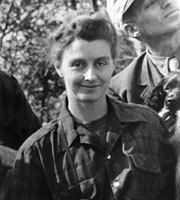Died 11 November 2004 | ||
 | ||
Shirley Ann Briggs (May 12, 1918 – November 11, 2004) was an American artist, writer and editor, and naturalist. She spent a large portion of her career participating in efforts to inform the public about the environment and synthetic chemicals such as pesticides. Shirley Briggs died on November 11, 2004 from cardiopulmonary failure.
Contents
Education
Briggs was the only child of Nellie Briggs and John Ely Briggs, a professor of political science at the University of Iowa. She was born in Iowa City, Iowa, graduated from University High School and then attended the University of Iowa. In 1939, she graduated summa cum laude from the University of Iowa, having earned a B.A in art, art history, and botany. She then went on to get an M.A in art and art history in 1940. During her time at Iowa, she studied under Grant Wood, the artist behind the famous painting “American Gothic”. In 1995, Briggs received the Distinguished Alumni Award from the University of Iowa.
Career
After graduating from the University of Iowa, Shirley Briggs briefly taught art at North Dakota State College. However, after many of her students were drafted into military service during World War II, she became an illustrator for the Glenn L. Martin Company in Baltimore, where she illustrated airplane manuals for use by servicemen. In the late 1945, Briggs moved on to work as an information specialist and illustrator for the United States Fish and Wildlife Service, a branch of the U.S. Department of the Interior, where she provided artwork and writing for a number of publications. In 1947, Briggs became the Chief of the Graphic section of the U.S. Bureau of Reclamation after her previous position with the U.S. Fish and Wildlife Service was given to war veteran. She remained in this position for seven years, working on graphics for a number of uses, such as hearings and museum exhibits. Beginning in 1954, Briggs was also responsible for the design and creation of several of the dioramas present in the Smithsonian Institution’s Museum of Natural History. Two of these dioramas were "The Pronghorn Antelope" and "The Carolina Parakeet."
In the midst of her career with the U.S. government, Shirley Briggs gained employment in the Audubon Naturalist Society in 1948, where she worked as an editor of The Wood Thrush, a periodical published by the organization. This periodical was later renamed The Atlantic Naturalist, of which Briggs became the editor in chief. Her work with the Audubon Naturalist Society entailed writing, photography, and other forms of art. Prior to her employment as an editor for the Audubon Naturalist Society, she had volunteered in its education and publication departments. Briggs was also a longtime teacher of courses on U.S. conservation philosophy and politics for the Audubon Naturalist Society and U.S. Department of Agriculture. Her contributions to the Audubon Naturalist Society resulted in her receiving the Paul Bartsch Award in 1972.
Upon helping found the Rachel Carson Council (then called the Rachel Carson Trust for the Living Environment) in 1965, she worked with other members to write the book A Basic Guide to Pesticides: Their Characteristics and Hazards, which was a large study about synthetic chemicals used for various purposes, such as agriculture and manufacturing. This book was published in 1992 and resulted in the EPA awarding Briggs the Rachel Carson Award and the University of California awarding her the Robert Vanden Bosch Award.
Affiliation with Rachel Carson
In the 1940s, Shirley Briggs became employed with the U.S. Fish and Wildlife Service, where she worked as an illustrator. It was here that she met Rachel Carson and forged their friendship. During her employment at the U.S. Fish and Wildlife Service, Briggs contributed to several of Carson’s publications, such as the “Chincoteaque: A National Wildlife Refuge” illustrated pamphlet, published in 1947.
Both women were involved in the Audubon Naturalist Society, and they frequently traveled together on expeditions organized by the ANS. On these trips, Briggs took a number of well-known photographs of Carson, and throughout their friendship, they also engaged in a letter correspondence. Later on, Briggs collaborated with Carson on research for the latter’s book, Silent Spring.
After Rachel Carson died in 1964, Shirley Briggs worked to preserve Carson’s work in Silent Spring. She wrote several papers to follow up on Carson's publication, such as "A Decade After Silent Spring," which discussed Carson's process, and "Silent Spring: The View from 1990," which described Carson's national impact and critically examined the Environmental Protection Agency's response. In 1965, Briggs and several others affiliated with Rachel Carson created the Rachel Carson Trust for the Living Environment, now called the Rachel Carson Council. Within this organization, she served as executive director from 1970-1992.
